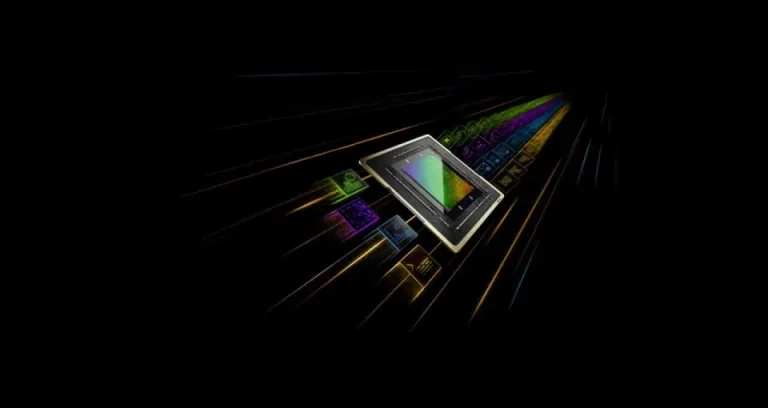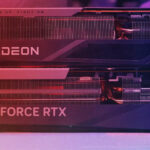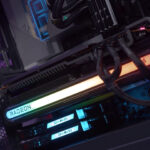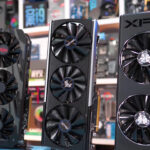NVIDIA’s latest offering, the RTX 500 and 1000 Ada GPUs, targets a specific niche: thin and light workstations often used by content creators, researchers, and video editors. While not aiming to compete with high-end desktop GPUs in raw power, these mobile cards pack an AI punch, promising improved performance and efficiency for tasks heavily reliant on artificial intelligence.
Strengths:
- Designed for thin and light workstations: Compact form factor fits seamlessly into mobile workstations, making them ideal for on-the-go professionals.
- AI acceleration: Boosted performance for AI-powered workloads, including tasks like photo editing, video editing, and generative AI models. Compared to a CPU alone, the RTX 500 claims up to 3x faster photo editing and the RTX 1000 boasts up to 14x quicker performance for specific generative AI models.
- Improved graphics performance: Offers a significant boost in graphics performance compared to integrated graphics, making it suitable for 3D rendering and other graphics-intensive tasks.
- DLSS 3 support: Utilizes NVIDIA’s latest DLSS 3 technology, enhancing image quality and frame rates while maintaining high resolution, crucial for smooth user experience.
- AV1 encoding support: Supports the latest AV1 video codec, offering improved efficiency for video streaming, broadcasting, and video calls compared to older codecs like H.264.
Weaknesses:
- Lower raw power compared to desktop GPUs: Not intended to compete with high-performance desktop graphics cards in terms of raw power. Users demanding top-tier performance for intensive gaming or professional creative work might need to look elsewhere.
- Limited memory options: The RTX 500 comes with 4GB of GDDR6 memory, while the RTX 1000 offers 6GB. This might be a limiting factor for certain applications requiring larger memory buffers.
Overall:
The NVIDIA RTX 500 and 1000 Ada GPUs cater to a specific audience: professionals who prioritize portability and require AI acceleration for their work. They offer a compelling combination of compact size, improved AI performance, and decent graphics capabilities. However, users seeking the absolute best performance for demanding tasks might need to consider higher-end desktop options.
A summary for different user groups:
- Content creators and video editors: These GPUs can significantly accelerate AI-powered workflows, making them a good choice for creators who need a balance between portability and performance.
- Researchers and scientists: The AI capabilities can be beneficial for research involving AI models and data analysis.
- Gamers: While offering improved graphics compared to integrated graphics, these GPUs are not intended for hardcore gamers seeking the highest possible performance in the latest titles.
The decision of whether the RTX 500 or 1000 Ada GPUs are the right choice depends on your individual needs and priorities.
Forget bulky desktops; NVIDIA’s RTX 500 and 1000 Ada GPUs bring the power of AI to thin and light workstations, empowering professionals on the go. While they might not be heavyweight champions in raw graphics power, these GPUs pack a sneaky punch in the realm of artificial intelligence.
Mobility Meets AI Muscle:
Imagine seamlessly editing photos, rendering 3D models, or working with cutting-edge AI models – all from the comfort of your portable workstation. This is the vision NVIDIA brings to life with the Ada GPUs. Compared to relying solely on a CPU, these mobile powerhouses offer:
- Up to 3x faster photo editing: Say goodbye to tedious editing times with the RTX 500.
- Up to 14x quicker performance for specific AI models: The RTX 1000 unleashes the potential of AI tools like Stable Diffusion, significantly accelerating your workflow.
Beyond AI Acceleration:
The Ada GPUs go beyond just AI. They also deliver:
- Improved graphics performance: Experience a noticeable leap in graphical capabilities compared to integrated graphics, making them suitable for light gaming and 3D design work.
- Smooth visuals with DLSS 3: Enjoy sharper visuals and boosted frame rates with NVIDIA’s latest DLSS technology, ensuring a seamless user experience.
- Future-proofed video encoding: With AV1 encoding support, these GPUs offer superior efficiency for video calls, streaming, and broadcasting compared to older codecs.
A Note on Trade-offs:
While offering impressive features, it’s important to remember that these GPUs prioritize portability over raw power. If you’re a hardcore gamer or require the absolute best performance for demanding creative work, high-end desktop options might be a better fit. Additionally, memory limitations (4GB for RTX 500, 6GB for RTX 1000) might affect specific applications requiring larger buffers.
Who should consider these GPUs?
- Content creators and video editors: Enjoy the benefits of AI-powered editing tools and decent graphics capabilities in a portable package.
- Researchers and scientists: Leverage the AI capabilities for tasks involving data analysis and working with AI models.
- Professionals on the go: Anyone who prioritizes portability and needs a boost for AI-powered workflows can benefit from these GPUs.
Ultimately, the choice comes down to your specific needs. If you’re a professional seeking a balance between portability and AI-powered performance, the RTX 500 and 1000 Ada GPUs offer a compelling solution. However, if raw power is your top priority, explore the world of high-end desktop graphics cards.







